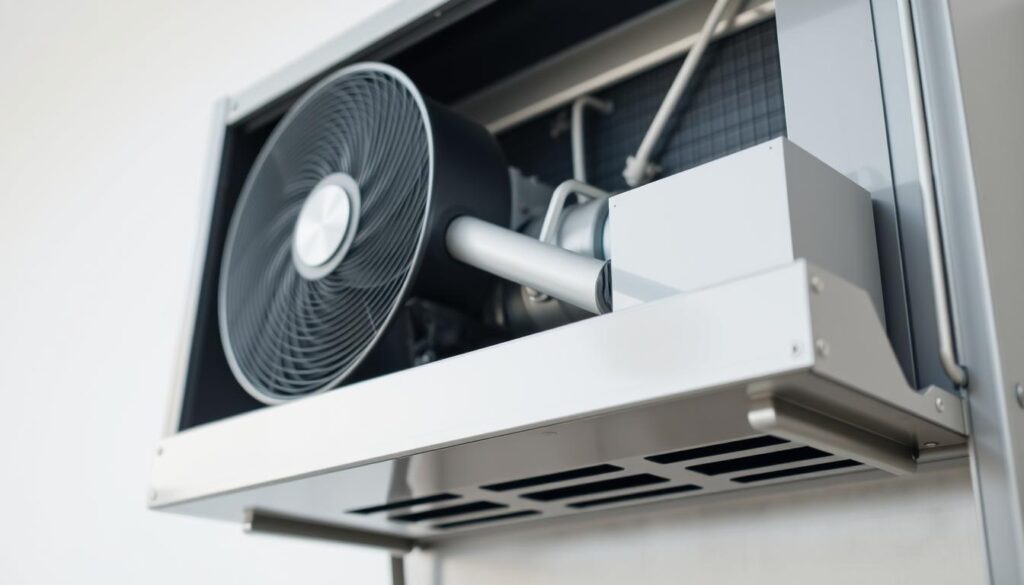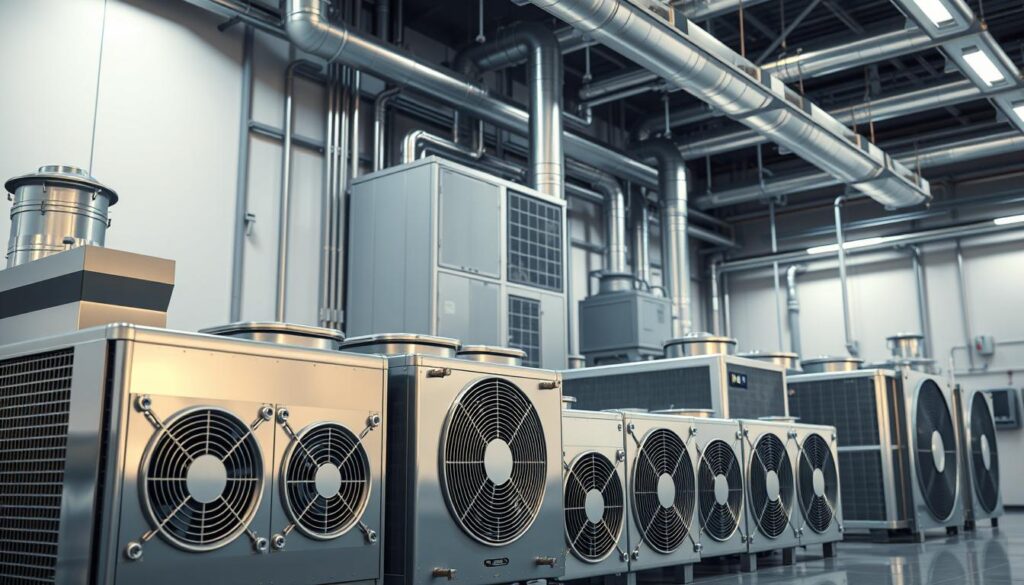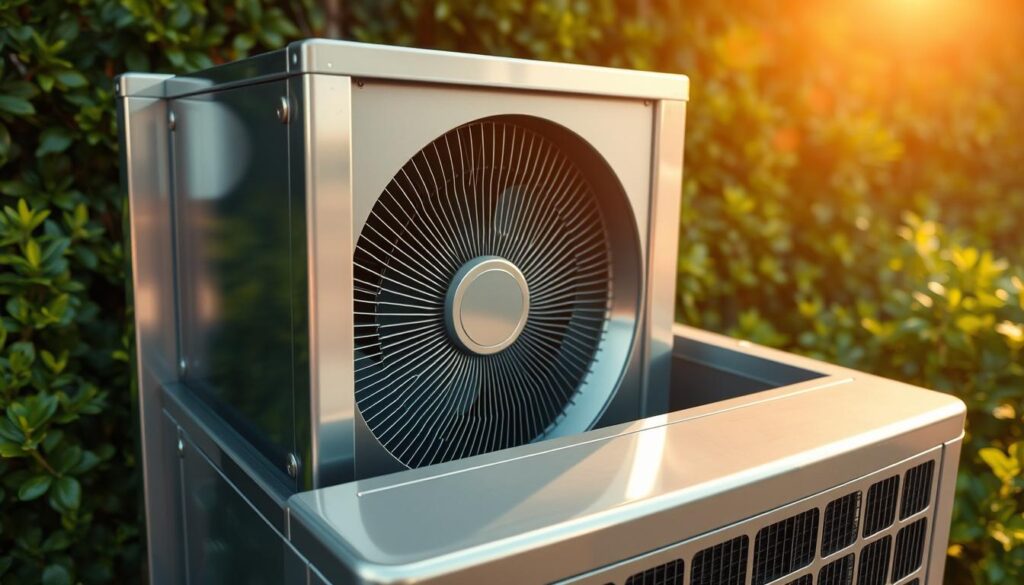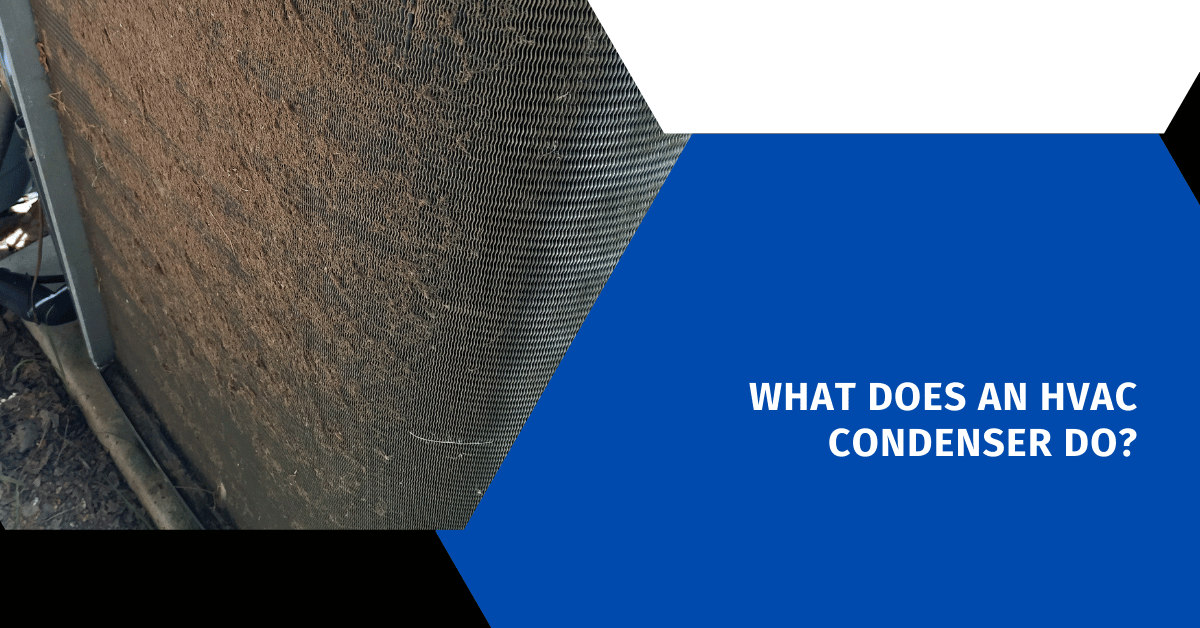Affiliate Disclosure
HVAC Guide Guys is a participant in the Amazon Services LLC Associates Program, an affiliate advertising program designed to provide a means for sites to earn advertising fees by advertising and linking to Amazon.
What Does an HVAC Condenser Do? Ever wondered about the device outside your home that keeps you cool? Your HVAC condenser is key to indoor comfort. Yet, many homeowners don’t know much about it.

The HVAC condenser is the cooling system’s unsung hero. It sits outside and releases heat from your home. This makes your indoor air cool and refreshing.
The condenser’s main job is to move heat from inside to outside. It does this by compressing and cooling refrigerant. This keeps your home cool, even when it’s very hot outside.
Key Takeaways
- HVAC condensers are vital for cooling systems
- They’re outside, releasing heat from inside
- Refrigerant is essential for cooling
- Keeping the condenser in good shape is important
- Knowing how it works improves your home’s comfort
Table of Contents
Understanding the Basics of HVAC Condensers
Your air conditioning system’s condenser is key to keeping your home cool. It’s the outdoor unit that removes heat, turning warm air into cool air. Knowing how it works helps you understand your cooling system better.
Key Components of a Condenser Unit
A cooling system condenser has important parts for heat transfer:
- Condenser Coil: Made of copper or aluminum for efficient heat exchange
- Compressor: Pressurizes refrigerant and moves it through the system
- Condenser Fan: Helps dissipate heat by circulating air across the coils
- Electrical Controls: Manage the unit’s operation and temperature regulation
The Role of Refrigerant in Condenser Operation
Refrigerant is vital for your cooling system. It changes from a gas to a liquid in the condenser, releasing heat. This change is key for cooling your home.
| Refrigerant Characteristic | Function in Condenser |
|---|---|
| Phase Change | Converts from gas to liquid, releasing heat |
| Pressure Transformation | Enables efficient heat transfer process |
| Temperature Regulation | Helps maintain optimal cooling performance |
Location and Installation Requirements
Your HVAC condenser goes outside your home. It needs a clear, level space with good air flow. A pro install ensures it works well for a long time.
Explore Our HVAC Shop
Looking for top-rated HVAC tools, parts, and accessories? Visit our shop and find the perfect solution for your needs.
Visit the ShopThe Core Function of an Air Conditioning Condenser
When it’s hot outside, your air conditioning system has a key part called the condenser. It’s a heat transfer wonder that cools your home by removing heat.
The condenser moves heat from inside your home to the outside. It works like a heat exchanger. It changes high-pressure, hot refrigerant into cooler liquid, starting the cooling cycle again.
- Transforms hot refrigerant into cooler liquid
- Releases heat from indoor air to external environment
- Enables continuous cooling process
Think of your condenser as a heat rejection system. It gets hot refrigerant from the compressor and cools it down with outside air. The fan blowing across the coils helps get rid of heat fast, keeping your home cool on hot days.
The efficiency of this heat transfer depends on several things:
- Condenser coil design
- Ambient temperature
- Refrigerant type
- Airflow around the unit
Understanding your condenser’s function can help you appreciate the complex engineering behind keeping your home cool and comfortable.
What Does an HVAC Condenser Do?
Understanding an HVAC condenser is key to knowing how your cooling system works. It plays a big role in heat transfer and keeping your home cool.
An HVAC condenser is the heart of your cooling system. It takes heat from inside your home and sends it outside. Let’s dive into how it works.
Heat Transfer Process
The heat transfer in HVAC condensers is complex but effective. It turns warm indoor air into cool air. Here’s the process:
- Refrigerant absorbs heat from indoor air
- Compressed gas moves through condenser coils
- Heat is expelled to the external environment
- Refrigerant transforms from gas to liquid state
Compression and Cooling Cycle
Your HVAC system’s cooling cycle relies on precise compression and temperature control. The compressor is key. It compresses refrigerant, making it possible for efficient heat exchange.
“The magic of cooling happens when refrigerant changes states, moving heat from inside to outside.” – HVAC Engineering Experts
Energy Efficiency Factors
Condenser performance affects your system’s energy efficiency. Important factors include:
| Efficiency Factor | Impact on Performance |
|---|---|
| Coil Cleanliness | Higher efficiency with clean coils |
| Refrigerant Charge | Optimal levels ensure maximum cooling |
| External Temperature | Affects heat transfer effectiveness |
Regular maintenance keeps your HVAC condenser running well. This ensures your home stays comfortable while using less energy.
Explore Our HVAC Shop
Looking for top-rated HVAC tools, parts, and accessories? Visit our shop and find the perfect solution for your needs.
Visit the ShopEssential Components Inside Your HVAC Condenser
Knowing about the condenser unit basics is key for homeowners to keep their HVAC systems running well. Your air conditioning condenser has important parts that work together. They help manage heat and cool your space.
The main parts of the hvac condenser function are essential. They change warm air into cool air for your comfort:
- Compressor: The heart of the condenser, which pressurizes refrigerant
- Condenser Coil: Releases heat from the refrigerant to the outside environment
- Fan: Helps dissipate heat by moving air across the condenser coils
- Refrigerant Lines: Carry cooling fluid through the system
Let’s dive deeper into these parts to understand their roles:
| Component | Primary Function | Importance |
|---|---|---|
| Compressor | Compress refrigerant | Increases refrigerant pressure and temperature |
| Condenser Coil | Release heat | Transforms high-pressure gas into liquid |
| Fan | Move air | Accelerates heat dissipation process |
| Expansion Valve | Control refrigerant flow | Regulates cooling system efficiency |
By knowing these condenser unit basics, you’ll appreciate the engineering in your home’s cooling system. Each part is vital for your HVAC system to work well and efficiently.
The Cooling Cycle: How Condensers Remove Heat
Understanding the cooling system condenser is key to knowing how your air conditioning works. It plays a vital role in moving heat from inside your home to the outside.
Your HVAC system uses a complex heat transfer process. It involves many parts working together smoothly.
Step-by-Step Heat Exchange Process
The heat exchange in a cooling system condenser happens in a specific order:
- Refrigerant enters as a high-pressure, high-temperature gas
- Hot gas moves through condenser coils
- External air passes over the coils, absorbing heat
- Refrigerant transforms from gas to liquid state
Role of the Compressor and Fan
Your HVAC’s compressor and fan are key to its function. The compressor makes refrigerant pressure higher. The fan helps move air around.
| Component | Primary Function | Heat Transfer Impact |
|---|---|---|
| Compressor | Pressurize Refrigerant | Increases Gas Temperature |
| Condenser Fan | Move External Air | Accelerates Heat Dissipation |
Temperature Control Mechanisms
Keeping temperatures right is all about control in your cooling system condenser. Sensors and valves work together to manage refrigerant flow. This ensures your cooling works well.
“The heart of efficient cooling is understanding how heat moves through your HVAC system.” – HVAC Engineering Experts
By understanding these complex processes, you can see the amazing engineering behind your home’s comfort system.
Types of HVAC Condensers in Modern Systems

It’s important to know about the different HVAC condensers for the best cooling. Today’s systems have many condenser designs. Each one is made for certain needs and places.
The main types of condensers in today’s HVAC systems are:
- Air-Cooled Condensers: Common in homes, these use outside air to cool the refrigerant
- Water-Cooled Condensers: Found in big commercial buildings, they cool better than air-cooled ones
- Evaporative Condensers: Use water and air to cool, working better than others
Carrier, a top HVAC maker, has many condenser options:
- Split System Air Conditioner Condensers
- Packaged AC Condensers
- Heat Pump Condensers
“Choosing the right condenser can really improve your system’s energy use and cooling.”
When picking a condenser, think about your climate, building size, and cooling needs. Each type has its own benefits for cooling. This way, you can find the best one for your needs.
Explore Our HVAC Shop
Looking for top-rated HVAC tools, parts, and accessories? Visit our shop and find the perfect solution for your needs.
Visit the ShopCommon Problems and Troubleshooting Tips
Your HVAC condenser is key to air conditioning. Spotting issues early can avoid expensive fixes and keep your system running well.
Signs of Condenser Malfunction
Spotting air conditioning problems needs careful watching. Look out for these signs:
- Warm air blowing from vents
- Unusual grinding or clicking noises
- Visible refrigerant leaks
- Corrosion on condenser coils
- Unexpected increases in energy bills
Maintenance Requirements
Regular upkeep stops sudden failures and makes your system last longer. Here’s what to do:
- Clean condenser coils every three months
- Clear debris around the outdoor unit
- Check refrigerant levels once a year
- Inspect electrical connections
- Lubricate moving parts
When to Call a Professional
Some HVAC problems need a pro. Call a technician if you see:
| Symptom | Professional Needed |
|---|---|
| Persistent refrigerant leaks | Immediate service required |
| Electrical component failures | Certified technician recommended |
| Complete system shutdown | Emergency repair needed |
Remember, timely professional maintenance can prevent costly replacements and ensure your air conditioning system runs efficiently.
Maximizing Condenser Efficiency and Performance

Boosting your cooling system condenser’s performance can cut down energy costs and make your HVAC last longer. Keeping it well-maintained is key for efficient heat transfer.
To get the most out of your condenser, try these tips:
- Regularly clean the condenser coils to stop dust and debris from building up
- Make sure there’s enough space around the outdoor unit for good airflow
- Check and keep the refrigerant levels right
- Get a pro to do annual maintenance checks
The spot where you place your cooling system condenser matters a lot. Keep it out of direct sunlight and away from dirt or plants that could block airflow. Putting it in the right spot can boost heat transfer efficiency by up to 15%.
Keeping your HVAC system in top shape is linked to energy efficiency. Simple actions like changing air filters often and keeping the condenser area clean can make a big difference. Homeowners can cut energy use by 10-15% with regular maintenance.
A well-maintained condenser is the key to a cool, efficient home during hot summer months.
Don’t forget about the seasons. In winter, cover your outdoor condenser unit to protect it from snow and ice. In summer, make sure it’s clear of grass clippings, leaves, and other stuff that can slow down heat transfer.
Choosing the Right Condenser for Your Home
Finding the perfect air conditioner condenser is key for comfort and saving energy. The right one boosts your HVAC system’s performance. It helps manage cooling needs and keeps utility costs low.
Understanding what an HVAC condenser does is vital. Your choice affects the system’s effectiveness and reliability over time.
Size and Capacity Considerations
Choosing the right condenser size is important. It depends on:
- Total square footage of your living space
- Regional climate conditions
- Home insulation quality
- Number of windows and sun exposure
Energy Efficiency Ratings
The Seasonal Energy Efficiency Ratio (SEER) rating is critical. Higher SEER ratings mean:
- Lower energy use
- Lower electricity bills
- Better for the environment
- Possible tax benefits
Cost and Installation Factors
Buying an air conditioner condenser involves financial considerations. Look at:
- Installation complexity
- Long-term operating costs
- Maintenance needs
- Warranty coverage
Getting professional advice helps make the right choice. It ensures your condenser meets your cooling needs and saves energy.
Explore Our HVAC Shop
Looking for top-rated HVAC tools, parts, and accessories? Visit our shop and find the perfect solution for your needs.
Visit the ShopHow to Maintain Your HVAC Condenser
Keeping your HVAC condenser unit in good shape is key. It ensures your air conditioning works well and lasts longer. Regular care helps avoid expensive repairs and keeps your system running smoothly.
To keep your condenser unit in top shape, follow these important steps:
- Clean the exterior unit regularly, removing debris and vegetation
- Inspect the condenser coils for dirt and dust buildup
- Check refrigerant levels annually
- Ensure proper clearance around the unit
- Straighten any bent condenser fins
Professional maintenance is key to long-term HVAC system health. While you can do some tasks yourself, some complex maintenance needs a certified HVAC technician. They can do detailed inspections that go beyond simple cleaning and checks.
Your seasonal maintenance routine should include:
- Spring cleaning before cooling season
- Fall inspection before winter
- Quarterly visual inspections
- Annual professional service
Watch for warning signs that your condenser needs quick attention:
- Unusual noises
- Reduced cooling efficiency
- Ice formation on the unit
- Increased energy bills
Remember, preventative maintenance is always less expensive than major repairs or complete system replacement.
Conclusion
Your home’s cooling system relies on the refrigeration condenser’s role. It turns hot refrigerant into liquid, removing heat efficiently. This knowledge helps you keep your system running well.
The condenser works hard to move heat outside. This keeps your home cool in summer. Taking care of it can save energy and make your system last longer.
Knowing about your HVAC system helps you make better choices. Understanding the condenser’s role lets you work better with HVAC experts. This knowledge improves your home’s comfort and cooling efficiency.
Every part of your air conditioning system is important for cooling your home. Learning about your condenser helps it work better. This ensures reliable, efficient cooling for years.

